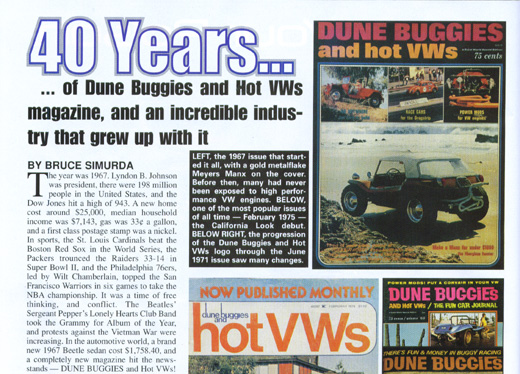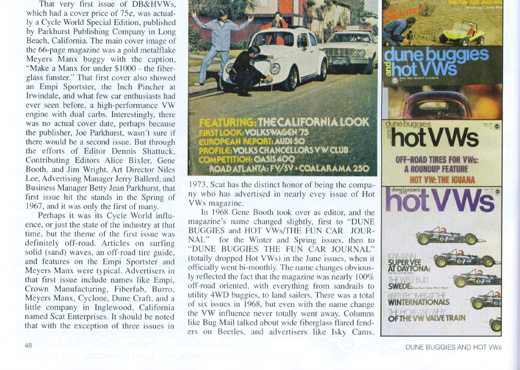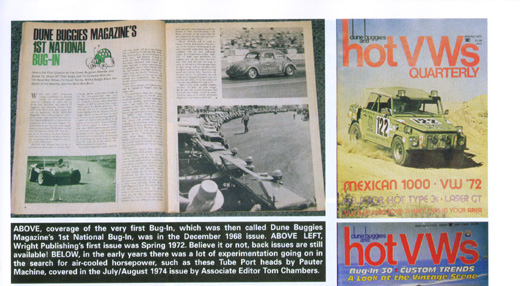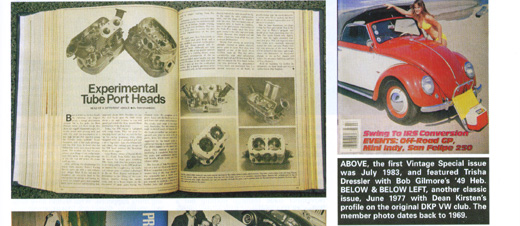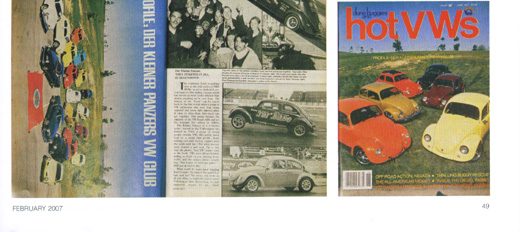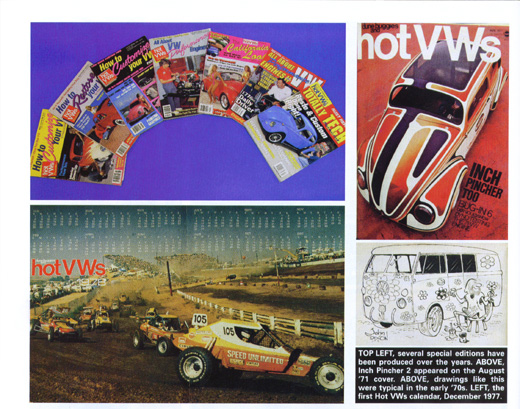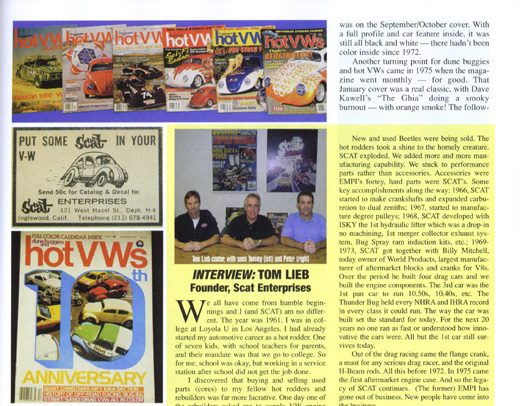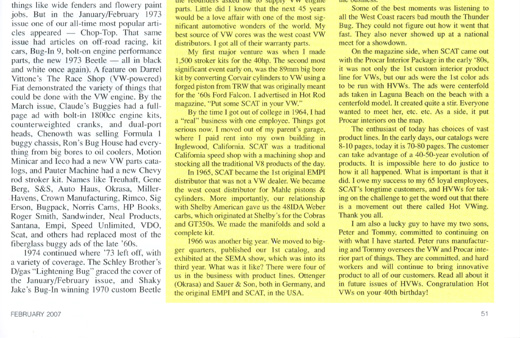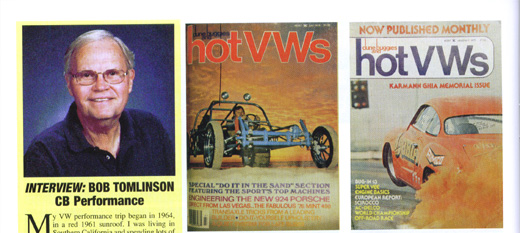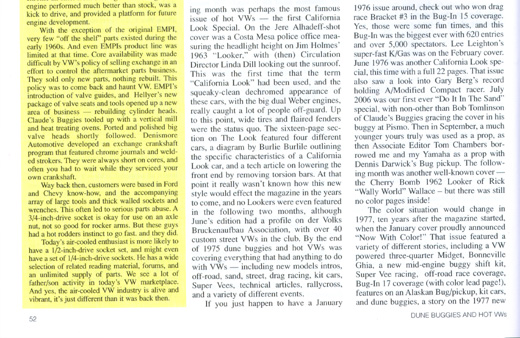|
Hot VW's - February 2007 - 40 Years of Dune Buggies and Hot VWs ..of Dune Buggies and Hot VW's magazine, and an incredible industry that grew up with it
40
Years
BY BRUCE SIMURDA The year was 1967. Lyndon B. Johnson was president, there were 198 million people in the United States, and the Dow Jones hit a high of 943. A new home cost around $25,000, median household income was $7,143, gas was 33 cents a gallon, and a first class postage stamp was a nickel. In sports, the St. Louis Cardinals beat the Boston Red Sox in the World Series, the Packers trounced the Raiders 33-14 in Super Bowl II, and the Philadelphia 76ers, led by Wilt Chamberlain, topped the San Francisco Warriors in six games to take the NBA championship. It was a time of free thinking, and conflict. The Beatles' Sergeant Pepper's Lonely Hearts Club Band took the Grammy for Album of the Year, and protests against the Vietnam War were increasing. In the automotive world, a brand new 1967 Beetle sedan cost $1,758.40, and completely new magazine hit the news-stands - DUNE BUGGIES and Hot VWs! That very first issue of DB&HVW's, which had a cover price of 75 cents, was actually a Cycle World Special Edition, published by Parkhurst Publishing Company in Long Beach, California. The main cover image of the 66-page magazine was a gold metalflake Meyers Manx buggy with the caption, "Make a Manx for under $1000 - the fiber-glass funster." That first cover also showed an Empi Sportster, the Inch Pincher at Irwindale, and what few car enthusiasts had even seen before, a high-performance VW engine with dual carbs. Interestingly, there was no actual cover date, perhaps because the publisher, Joe Parkhurst, wasn't sure if there would be a second issue. But through the efforts of Editor Dennus Shattuck, Contributing Editors Alice Bixler, Gene Booth, and Jim Wright, Art Director Niles Lee, Advertising Manager Jerry Ballerd, and Business Manager Betty Jean Parkhurst, that first issue hit the stands in the Spring of 1967, and it was only the first of many. Perhaps it was its Cycle World influence, or just the state of the industry at that time, but the theme of the first issue was definately off-road. Articles on surfing solid (sand) waves, an off-road tire guide, and features on the Empi Sportster and Meyers Manz were typical. Advertisers in that first issue include names like Empi, Crown Manufacturing, Fiberfab, Burro, Meyers Manx, Cyclone, Dune Craft, and a little company in Inglewood, California named Scat Enterprises. It should be noted that with the exception of three issues in 1973, Scat has the distinct honor of being the company who has advertised in nearly every issue of Hot VWs magazine. In 1968, Gene Booth took over as editor, and the magazine's name changed slightly, first due to "DUNE BUGGIES and HOT VW's/THE FUN CAR JOURNAL" for the Winter and Spring issues, then to "DUNE BUGGIES THE FUN CAR JOURNAL," (totally dropped the Hot VW's) in the June issues, when it officially went bi-monthly. The name changes obviously reflected the fact that the magazine was nearly 100% off-road oriented, with everything from sandrails to utility 4WD buggies, to land sailers. There was a total of six issues in 1968, but even with the name change the VW influence never totally went away. Columns like Bug Mail talked about wide fiberglass flared fenders on Beetles, and advertisers like Isky Cams, Revmaster, Vee Service Unlimited, Competition Products, the Santana Company (degreed aluminum pulley), and Scat sand the praises of performance products to hop-up the lowly air-cooled engine. Tom Bates took over as editor starting with the August 1968 issue. In 1969, DUNE BUGGIES made another frequency change, and went monthly, starting with a February issue (11 in all that year). The look and emphasis of the magazine remained pretty much unchanged, but the increasing influence of VW-powered machines was already becoming evident. In June an article on Bug-In 2 appeared, showing the variety of VW's in both off-road and street trim. Ads for Unique Dune Buggy Supply (now Unique Supply, Inc.) and Dee Engineering (Bugpack Products) first appeared in the April issue, with Kennedy Engineered Products advertising in May. Bug-Formance made its advertising debut in the June issue. While the focus of the magazine was still mainly off-road, changes were already brewing when the first 1970 issue hit the stands. In fact, by April another big name change hit, this time back to Dune Buggies and Hot VW's. But that issue also marked another milestone, as it was the first time that an off-roader or kit car was not the main cover subject - it was Dean Lowry's Deano Dyno Soars race car! Along with stories on the EMPI company, a tech article on the Beetle's front end, plus a segment from John Muir's popular book, "How To Keep Your Volkswagen Alive," Volkswagens were once again a main part of the magazine. As 1970 progressed, the emphasis on performance street increased to where the Novermber issue featured nothing but a Weber 48 IDA equipped Scat engine on the cover. In that same issue, the "dune buggies" portion of the title, which had been the same size as "Hot VW's", became noticeable smaller. Another big milestone came in the September 1970 issue - inside color. Up to this point the only color pages in the magazine were the front and back covers. In 1971, the progression from buggies to VWs continued, to the point where feature articles on customized Beetles and buses were a regular part of the magazine. Of course, tech article on modifying the air-cooled engine increased to match the number of advertisers selling high performance VW components, including a new advertiser who appeared in the March 1971 issue - Claude's Buggies (now CB Performance) with an ad for piston and cylinder kits. In the May 1971 issue, the title words "dune buggies" shrank once again, to where hot VW's was the prominent title. Just one month later the words "dune buggies and" shrank once again, so they fit between the "h" and "t" in hot, similar to the title you see today. (Also in the June issue, Esslinger Hydraulics placed their first ad for "Buggy Reins" turning brakes.) But the title change definately fit the changing editorial of the magazine, which was much more street/strip oriented than ever before. But then another interesting thing happened. What should have been the October issue was labeled "Winter 1971," and the title now ended with the word, "QUARTERLY!" The year 1972 was perhaps the most important in the history of dune buggies and hot VW's magazine. Starting with the Spring 1972 issue, Jim Wright, who had previously been the Technical Editor, purchased the magazine from Parkhurst Publishing, and started Wright Publishing Company. (See article on Wright Publishing's 35th Anniversary on page 78). Under Jim's reign as publisher and editor, dune buggies and hot VW's QUARTERLY had a balanced editorial package, with off-road, drag racing, new model reviews, events, technical articles, Super Vee racing, car features, and more. The combination apparently worked, because just two issues later it again went bi-monthly with the October 1972 issue. Moving into 1973, you could see a new industry actually taking shape. Up to this point, the majority of the street customs has things like wide fenders and flowery paint jobs. But in the January/ February 1973 issue one of our all-time most popular articles appeared - Chop-Top. That same issue had articles on off-road racing, kit cars, Bug-In 9, bolt-on engine performance parts, the new 1973 Beetle - all in black and white once again). A feature on Darrel Vittone's The Race Shop (VW-powered) Fiat demonstrated the variety of things that could be done with the VW engine. By the march issue, Claude's Buggies had a full-page ad with bolt-in 1800cc engine kits, counterweighted cranks, and dual-port heads, Chenowth was selling Formula 1 buggy chassis, Ron's Bug House had everything from big bores to oil coolers, Motion Minicar and Ieco had new VW parts catalogs, and Pauter Machine had a new Chevy Rod Stroker Kit. Names like Treuhaft, Gene Berg, S&S, Auot Haus, Okrasa, Miller-Havens, Crown Manufacturing, Rimco, Sig Erson, Bugpack, Norris Cams, HP Books, Roger Smith, Sandwinder, Neal Products, Santana, Empi, Speed Unlimited, VDO, Scat, and others had replaced most of the fiberglass buggy ads of the late '60s. 1974 continued where '73 left off, with a variety of coverage. The Schley Brother's D/gas "Lightening Bug" graced the cover of the January/February issue, and Shaky Jake's Bug-In winning 1970 custom Beetle was on the September/October cover. With a full profile and car feature insude, it was still all black and white - there hadn't been color inside since 1972. Another turning point for dune buggies and hot VW's came in 1975 when the magazine went monthly - for good. That January cover was a real classic, with Dave Kawell's "The Ghia" doing a smoky burnout - with orange smoke! The following month was perhaps the most famous issue of Hot VW's - the first California Look Special. On the Jere Alhadeff-shot cover was a Costa Mesa police officer measuring the headlight height of Jim Holmes' 1963 "Looker" with (then) Circulation Director Linda Dill looking out the sunroof. This was the first time that the term "California Look" had been used, and the squeaky-clean dechromed appearance of these cars, with the big dual Weber engines, really caught a lot of people off-guard. Up to this point, wide tires and flaired fenders were the status quo. The sixteen-page section on The Look featured four different cars, a diagram by Burlie Burlile outlining the specific characteristics of a California Look car, and a tech article on lowering the front end by removing torsion bars. At that point it really wasn't known how this new style would effect the magazine in the years to come, and no Lookers were even featured in the following two months, although June's edition had a profile on der Volks Bruckenaufbau Association, with over 40 custom street VWs in the club. By the end of 1975 dune buggies and hot VWs was covering everything that had anything to do with VWs - including new model intros, off-road, sand, street, drag racing, kit cars, Super Vees, technical articles, rallycross, and a variety of different events. If you just happento have a January 1976 issue around, check out who won drag race Bracket #3 in the Bug-In 15 coverage. Yes, those were some fun times, and this Bug-In was the biggest ever with 620 entries and over 5,000 spectators. Lee Leighton's super-fast K-Gas was on the February cover. June 1976 was another California Look special, this time with a full 22 pages. That issue also saw a look into Gary Berg's record holding A/Modified Compact racer. July 2006 was our first ever "Do It In The Sand" special, with non-other than Bob Tomlinson of Claude's Buggies gracing the cover in his buggy at Pismo. Then in September, a much younger yours truly was used as a prop, as then Associate Editor Tom Chambers borrowed me and my Yamaha as a prop with Dennis Darwick's Bug pickup. The following month was another well-known cover - the Cherry Bomb 1962 Looker of Rick "Wally World" Wallace - but there was still no color pages inside! The color situation would change in 1977, ten years after the magazine started, when the January cover proudly announced "Now With Color!" That issue featured a variety of different stories, including a VW powered three-quarter Midget, Bonneville Ghia, a new mid-engine buggy shift kit, Super Vee racing, off-road race coverage, Bug-In 17 coverage (with color lead page!), features on an Alaskan Bug/pickup, kit cars, and dune buggies, a story on the 1977 new model lineup from Volkswagen, and a 40-Horse Rebuild series. Just a few months later, the Der Kleiner Panzers (DKP) VW club was profiled, setting them apart as the premier street high-performance VW club of the time. So after a decade of transformation, dune buggues and hot VWs magazine celebrated its 10th anniversary in the December 1877 issue with additional color, including a centerspread calender. With then years under its belt, Hot VWs was unquestionably the leader in its field, and a major influence on an industry that had grown up with it. From the Bug-Ins at Orange County International Raceway to the desert races of Baja California, if it was VW related "hot VWs" was on the scene to cover it. And the VW influence was far reaching, evidenced by covers with celebrities like Rick and Roger Mears, Don Garlits, Tom McEwen, Ivan Stewart, and Cory McClenathan. As the street, strip, and off-road, and other industries changed, the content of the magazine changed to reflect it. In fact, there were two "spin-offs" of Hot VWs - 3 Wheeling in 1980 and SAND SPORTS in 1995 - to properly cover markets that were growing seperately from the VW scene. Special theme issues were added to reflect the changes in the industry, such as the annual Vintage Special which began in July 1983. Other special editions appeared throughout the years, including How To Customize Your VW I and II (Spring 1988 and Spring 1989). How To Restore Your VW (Summer 1988), All About VW Performance Engines I and II (Winter 1989 and Fall 1997, The California Look (Summer 1995), and Totally Tech (Summer 2002). All in all, this is the 443rd edition of dune buggies and hot VWs magazine, and we certainly look forward to our 50th anniversary. There are definately more changes in the industry ahead, but that's what dune buggies and hot VWs has been about from the very beginning.
INTERVIEW:
TOM LIEB
We all have come from humble beginnings and I (and SCAT) am no different. The year was 1961, I was in college at Loyola U in Los Angeles. I had already started my automotive career as a hot rodder. One of seven kids, with school teachers for parents, and their mandate was that we go to college. So for me, school was okay, but working in a service station after school did not get the job done. I discoverd that buying and selling used parts (cores) to my fellow hot rodders and rebuilders was far more lucrative. One day, one of the rebuilders asked me to supply VW engine parts. Little did I know that the next 45 years would be a love affair with one of the most significant automotive wonders of the world. My best source of VW cores was the west coast VW distributors. I got all their warranty parts. My first major venture was when I made 1,500 stroker kits for the 40hp. The second most significant event early on, was the 89mm big bore kit by converting Corvair cylinders to VW using a forged piston from TRW that was originally meant for the '60s Ford Falcon. I advertised in Hot Rod magazine, "Put some SCAT in your VW." By the time i got out of college in 1964, I had a "real" business with one employee. Things got serious now, I moved out of my parent's garage, where I paid rent into my own building in Inglewood, California. SCAT was a traditional California speed shop with a machining shop and stocking all the traditional V8 products of the day. In 1965, SCAT became the 1st original EMPI distributor that was not a VW dealer. We became the west coast distributor for Mahle pistons & cylinders. More importantly, our relationship with Shelby American gave us the 48 IDA Weber carbs, which originated at Shelby's for the Cobras and GT350's. We made the manifolds and sold a complete kit. 1966 was another big year. We moved to bigger quarters, published our 1st catalog, and exhibited at the SEMA show, which was into its third year. What was it like? There were four of us in the business with product lines. Ottenger (Okrasa) and Sauer & Son, both in Germany, and the original EMPI and SCAT, in the USA. New and used Beetles were being sold. The hot rodders took a shine to the homely creature. SCAT exploded. We added more and more manufacturing capability. We stuck to performance parts, rather than accessories. Accessories were EMPI's fortey, hard parts were SCAT's/ Some key accomplishments along the way: 1996, SCAT started to make crankshafts and expanded carburetion to dual zeniths; 1967, started to manufacture degree pulleys; 1968, SCAT developed with ISKY the 1st hydraulic lifter which was a drop-in, no machining, 1st merger collector exhaust system, Bug Spray ram induction kits, etc.; 1969-1973, SCAT got together with Billey Mitchell, today owner of World Products, largest manufacturer of aftermarket blocks and cranks for V8s. Over the period he built four drag cars and we built the engine components. The 3rd car was the 1st pan car to run 10.50s, 10.40s, etc. The Thunder Bug held every NHRA and IHRA record in every class it could run. The way the car was built set to the standard for today. For the next 20 years no one ran as fast or understood how innovative the cars were. All but the 1st car still survives today. Out of the drag racing came the flange crank, a must for any serious drag racer, and the original H-Beam rods. All this before 1972. In 1975 came the first aftermarket engine case. And so the legacy of SCAT continues. (The former) EMPI has gone out of business. New people have come into the business. Some of the best moments was listening to all the West Coast racers bad mouth the Thunder Bug. They could not figure out how it went that fast. They also never showed up at a national meet for a showdown. On the magazine side, when SCAT came out with the Procar Interior Package in the early '80's, it was not only the 1st custom interior product line for VWs, but our ads were the 1st color ads to be run with HVWs. The ads were centerfold ads taken in Laguna Beach on the beach with a centerfold model. It created quite a stir. Everyone wanted to meet her, etc. etc. As a side, it put Procar interiors on the map. The enthusiast of today has choiced of vast product lines. In the early days, our catalogs were 8-10 pages, today it is 70-80 pages. The customer can take advantage of a 40-50-year evolution of products. It is impossible here to do justice to how it all happened. What is important is that it did. I owe my success to my 65 loyal employees, SCAT's longtime customers, and HVWs for taking on the challenge to get the word out that there is a movement out there called Hot VWing. Thank you all. I am also a lucky guy to have my two sons, Peter and Tommy, committed to continuing on with what I have started. Peter runs manufacturing and Tommy oversees the VW and Procar interior part of things. They are committed, and hard workers and will continue to bring innovative product to all of our customers. Read all about it in future issues of HVWs. Congratulation Hot VWs on you 40th birthday!
INTERVIEW:
BOB TOMLINSON
My VW performance trip begain in 1964, in a red 1961 sunroof. I was living in Southern California and spending lots of weekends at my Dads place (Claude's Buggies) in Farmersville, California where he was busy servicing and repairing VW's. I shared the same opinion about my '61 Bug as most of dad's customers. A 40hp VW was a great little car, and fun to drive, but mountain roads and headwinds really slowed it down. High performance parts were scarce and pricey, so we decided to pump up the engine using locally available sources. We removed and dissembled my engine and asked Denismore Automotive, an engine builder in Fresno, to bore the barrels 0.60-inch over. Pistons were supplied by Silverlite, and rings by Grant. Harry Weber reground the cam and the lifters, a local motorcycle mechanic ported the heads, we located a Bosch 010 (mechanical advance) distributor, and welded up a two-into-two crossover exhaust system. A Porsche 356 oil pump with larger gears was installed, along with a larger main jet and chrome air filter from Stellings and Hellings. The engine performed much better than stock, was a kick to drive, and provided a platform for future engine development. With the exception of the original EMPI, very few "off the shelf" parts existed during the early 1960's. And even EMPI's product line was limited at that time. Core availability was made difficult by VW's policy of selling exchange in an effort to control the aftermarket parts business. They sold only new parts, nothing rebuilt. This policy was to come back and haunt VW. EMPI's introduction of valve guides, and Hellyer's new package of valve seats and tools opened up a new area of business - rebuilding cylinder heads. Claude's Buggies tooled up with a vertical mill and heat treating ovens. Ported and polished big valve heads shortly followed. Denismore Automotive developed an exchange crankshaft program that featured chrome journals and welded strokers. They were always short on cores, and often you had to wait while they serviced your own crankshaft. Way back then, customers were based in Ford and Chevy know-how, and the accompanying array of large tools and thick walled sockets and wrenches. This often led to serious parts abuse. A 3/4 inch drive socket is okay for use on an axle nut, not so good for rocker arms. But these guys had a hot rodders instinct to go fast, and they did. Today's air-cooled enthusiast is more likely to have a 1/2 inch-drive socket set, and might even have a set of 1/4-inch-drive sockets. He has a wide selection of related reading material, forums, and an unlimited supply of parts. We see a lot of father/son activity in today's VW marketplace. And yes, the air cooled VW industry is alive and vibrant, it's just different than it was back then.
INTERVIEW:
BRUCE MEYERS
My first exposure to modified VWs was in 1962. We were at the Pismo Dunes playing with a sand sailer on the beach - you know, a sailing rig on wheels. The owner of a hummungous flame-belching Chrysler, Hemi-powered water-pumper had given me a ride in the dunes. Noisy, heavy and fun, it was no match for the stock VW with its body missing that had been shooting bowls with us. The VW guy sat on a stock driver's seat, steering column supported by a water pipe and elbow frame, the stock muffler dragging in the sand occasionally because the rid was still running on its original wheels and tires flitting about like a misquito on water! The only aftermarket name that I was aware of at the time was EMPI. Each time I went down to Chick Iverson's VW parts counter there was this display under glass, of which fabs, gear shift knobs, grass carpets, headrests and the like for your VW or Porsche. Or course the venerable Empi "camber compensator" was there too, a quality product. No doubt there were others in this budding aftermarket, but I hadn't taken notice. Obviously, there was no Hot VWs yet. Whenever we wanted wide wheels, we scavenged Iverson's body shop trash for good unbent wheel centers, replacing the bent rims with wider ones ourselves. When there was a need for turning brakes, skid plates, roll bars, tow bars, etc. we made them ourselves. At the time, at least to me, there was no visible industry yet and I wasn't interested in what Empi was doing. What I couldn't forget was that silly VW floorpan ripping up the Pismo Dunes. There was, however, a stirring of interest in a few home-built, VW-based dune buggies. These cars were very straighforward, seventy-five to eighty0inch wheelhouse, using VW axles and drivelines - always welded steel tubing frames, pop-riveted aluminum skins and very lightweight (around 1,000 pounds). Shod with fat tires, they were off-road amazing. I had already been exploring Baja with my friends in Volkswagen buses, and purchased a set of 9.50-15 wheels and tires from a sleeping Buick Ambulance at the local junkyard for $30. Using an acetylene torch and stick welder, I transferred the ambulance rims and tires to my VW bus centers. Discovering the need for more wheel well clearance, tin snips and a very large and persuasive hammer made room for the big weenies. This then was the ever-popular Little Red Riding Bus - great for roaming Baja in sleep-aboard comfort. I actually shot a few bowls with it laughably, but it would never be known as a duner. Here I was sitting over the front wheels when any dummy knew the weight was needed over the rear tires. And so I was standing at the threshold of the dawn of the Meyers Manx dune buggy. The many machines of man - cars, boats, planes and trains - are largely an evolution of empirical design. That is to rely on experience and observation as opposed to theory based on scientific conclusions. It wasn't very scientific of me to also observe that a Volkswagen, without its body is now much lighter, its engine and skinny tires having to do less to propel and support it on the sand dune. And if the tires were larger they would offer more surface-floatation, like snowshoes. And if the car were short in length it would bring the live ballast, driver and passenger, closer to the driving wheels - adding tractability. The short car is a lighter car and with a shorter turning radius, more belly clearance and is stronger in beam strength. This was what I had observed in 1962. This was a list of the basics underlying a sucessful dune buggy of those times - the nuts and bolts part. But I'm not just interested in the engineering, but also in the car's aesthetics - its looks. My formal education had been in the arts, drawing, painting, portraiture and figure drawing, which i once taught. Today's cars start their journey in the styling studios from sketches, scupltured models, and last with the engineers. There is always a careful balance between good engineering and the latest look, which often outpaces engineering. I had been working in the fiberglass sailboat industry for several years. I lofted from the Naval Architect drawings to full-size mockups, or plugs, from which molds are constructed to produce the fiberglass sail-boat industry for several years. I lofted from the Naval Architect drawings to full-size mockups, or plugs, from which molds are constructed to produce the fiberglass hulls, etc. This was my technical background. My fine art background, especially the figure drawing experience, gave the car its inherent gesture, which suggests an illusion of fun and freedom. This was the Manx's strongest feature. When you work in fibreglass, you think in fiberglass terms. Although I hadn't a clue as to the success that was to follow, I sensed that steel tubing and pop-riveted aluminum could never achieve the sculptural freedom, the pizzazz and impact of shiny, brightly colored surfaces of well-designed fiberglass. Nor could the pop-riveted car be as easy to reproduce. There followed a worldwide success, having its day in the sun, creating an industry with Manx accessories, many of which are still sold today. I built over 6,000 Meyers Manx kits, with a force of 60-70 people producing 25 kits a day at times, with a trucking fleet servicing 200 dealers, until i lost my court-room battle to uphold my patent. The Judge ruled that it shouldn't have been patented in the first place. Imagine! And it was a pop-riveted car that was shown to the judge as previous art that blew us out of court! A pop-riveted car that lacked all the attractive ingredients of the Meyers Manx! The very ingredients that made the Manx such a success, and a pop-riveted car that, by itself, never could have created the automotive phenomena that was to follow. At this ruling, the floodgates opened and the copycats flooded the market with, wouldn't you know it - fiberglass copies, at impossibly low prices, not pop-riveted ones. Meyers Manx closed its doors. In the forty-odd years since, the ubiquitous fiberglass Manx clones and copies have been produced in Australia, Europe, Africa, South America and at home numbering in the hundreds of thousands of cars. I've been called the inventor of the dune buggy, not true. I never invented the dune buggy or fiberglass, but I did bring the two together, thereby popularizing the dune buggy. That aesthetically unconcious 78-year-old judge in his very last courtroom case would never comprehend this. Some of the best times included driving Little Red Riding Bus along a Baja beach, towing a water-skier, drinking beer with others, singing to guitars playing inside the bus . . . all at once! Those years of exploring Baja gave us a leg-up when I set the first automobile record, beating the then existing motorcycle trans-Baja peninsular record. After Ed Pearlman and I brought together the first meeting forming NORRA (National Off-Road Racing Association), Meyers Manx later defended and came in first and second cars (with a pair of motorcycles in-between) in the first Baja Mexican 1,000! This led to the Score Baja 1,000, the granddaddy of all off-road races. All I was trying to do was sell more Meyers Manxs! So what did we get instead? Off-Road racing! Back then I had a 1953 VW Single Cab pick-up. Paid $450 for it, sold it for $400 - no big deal. Today, this car would be precious, and there is much more care given the old ones - and value. Today there is a kind of protectionist society of VW fans that hadn'y come about yet. There was no sense of this forty years ago, because rarity comes with the passage of time. |
